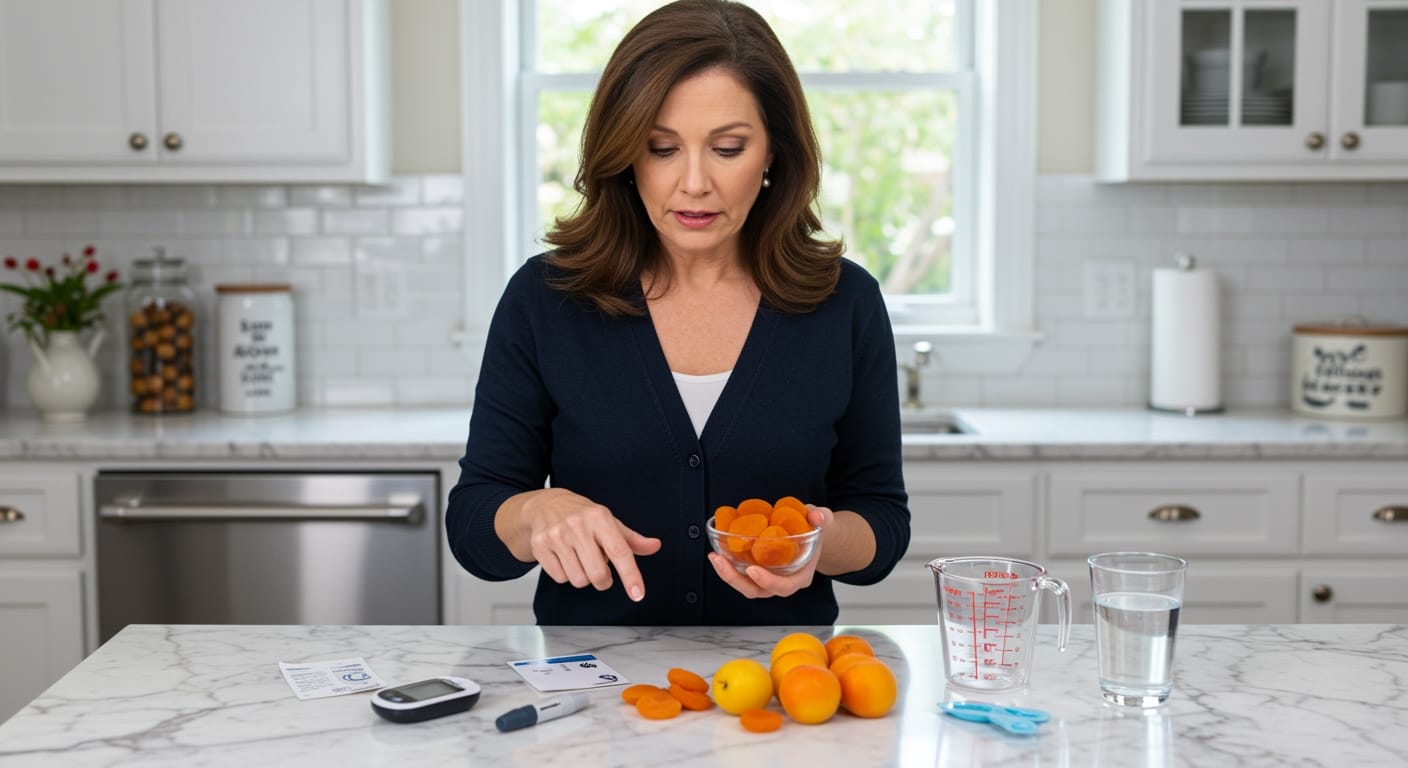✪ Key Takeaway: Dried apricots can be eaten by people with diabetes in small portions, but they cause higher blood sugar spikes than fresh apricots.
Introduction
You reach for that bag of dried apricots thinking you are making a healthy choice, but then doubt creeps in about your blood sugar.
Many people with diabetes wonder if dried fruits are safe because they taste so sweet and seem processed compared to fresh fruit.
Hi, I am Abdur, your nutrition coach and today I am going to explain exactly how dried apricots affect your blood sugar and whether they belong in your diabetes meal plan.
How Do Dried Apricots Affect Blood Sugar?
Dried apricots have a moderate glycemic index of around 35-40, which means they raise blood sugar more slowly than white bread or candy.
However, the concentration effect makes them more problematic than fresh apricots for blood sugar control.
When apricots are dried, the water gets removed but all the natural sugars remain packed into a much smaller space.
This means you can easily eat the equivalent of 6-8 fresh apricots in just a small handful of dried ones without realizing it.
Your digestive system breaks down the concentrated sugars quickly, causing glucose to enter your bloodstream faster than it would from fresh fruit.
The fiber content remains the same, but the sugar-to-fiber ratio becomes much higher in dried apricots, reducing the blood sugar buffering effect that fiber normally provides.
✪ Fact: Four dried apricot halves contain the same amount of sugar as one whole fresh apricot.
What Makes Dried Apricots Different From Fresh?
Fresh apricots contain about 86% water, which gets completely removed during the drying process.
This dehydration process concentrates not just the sugars but also the calories, making dried apricots much more calorie-dense.
One fresh apricot has about 4 grams of sugar and 17 calories, while four dried apricot halves contain 15 grams of sugar and 67 calories.
The satiety factor also changes dramatically because dried apricots do not trigger the same fullness signals that fresh fruit does.
Your brain relies on stomach stretch receptors to signal fullness, and dried fruits take up much less space in your stomach.
Some commercial dried apricots also contain added sulfur dioxide as a preservative, which can cause digestive issues in sensitive people but does not directly affect blood sugar.
The chewing time is also reduced with dried apricots, which means you miss out on the natural appetite control that comes from slower eating.
✪ Pro Tip: Soak dried apricots in water for 10 minutes before eating to slow down sugar absorption.
How Much Can You Safely Eat?
The safe portion size for dried apricots when you have diabetes is about 2-3 pieces or roughly 20-30 grams.
This portion contains approximately 10-15 grams of carbohydrates, which fits within most diabetes meal plans as one fruit serving.
Your individual carbohydrate tolerance will determine if you can handle this amount without significant blood sugar spikes.
People with better glucose control might tolerate slightly larger portions, while those with poor control should stick to smaller amounts.
The timing of consumption matters too – eating dried apricots with a protein source or healthy fat can help slow sugar absorption.
Never eat dried apricots on an empty stomach if you have diabetes, as this will cause the fastest and highest blood sugar spike.
Consider them as a dessert replacement rather than a snack, and always account for their carbohydrates in your daily meal planning.
✪ Note: Always test your blood sugar 2 hours after eating dried apricots to understand your personal response.
Are There Any Benefits For Diabetes?
Dried apricots do provide some nutritional benefits that can support overall health in people with diabetes.
They are rich in potassium, which helps regulate blood pressure – an important consideration since diabetes increases cardiovascular risk.
The beta-carotene content in dried apricots converts to vitamin A in your body, supporting eye health which can be compromised by diabetes.
They also contain iron, which can help prevent anemia that sometimes occurs alongside diabetes due to kidney complications.
The fiber content does provide some benefit for digestive health and can help with cholesterol management.
However, these benefits do not outweigh the blood sugar impact, so dried apricots should be treated as an occasional treat rather than a health food.
Fresh apricots provide the same nutritional benefits with much less impact on blood glucose levels.
✪ Fact: Dried apricots contain 3 times more potassium per serving than fresh apricots due to concentration.
The Bottom Line
Dried apricots can be part of a diabetes meal plan when eaten in very small portions and paired with protein or healthy fats.
“The key to managing diabetes is not avoiding all sweet foods, but understanding how to eat them safely and in moderation.”
I would love to hear about your experiences with dried fruits and diabetes management, so please share your thoughts or questions in the comments below.
At NutritionCrown, we use quality and credible sources to ensure our content is accurate and trustworthy. Below are the sources referenced in creating this article:
- Very Well Health: Dried Fruit Diabetes Risk
- Glycemic Index Net: Dried Apricots Glycemic Index
- Fitterfly: Is Apricot Good for Diabetes
- Apollo247: Relationship Between Apricot and Diabetes





